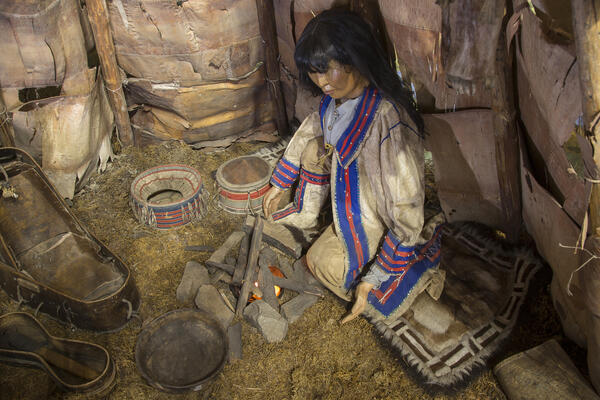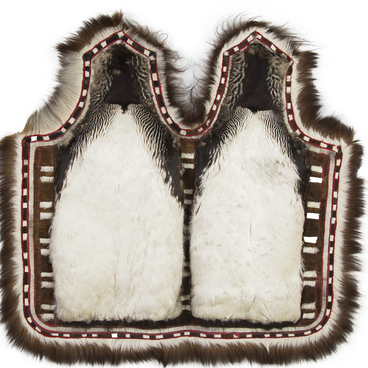The installation from the Museum of Local Lore represents the traditional rite of feeding the fire. It was the closing part of the wedding ritual of the Transbaikal Evenks.
The Evenks got married at various ages. In some Evenk tribes, it was customary to start matchmaking when a baby was just born or even before that. In other tribes, girls were ready for marriage only when they learnt how to look after cattle and take care of the family.
The cattle camps which belonged to the bride and the groom were set up closely to each other. Usually, a boundary line passed between them: a gully or a natural ditch.
The Evenk wedding ceremony included three main parts, which slightly differed from region to region. First, the bride was dressed and a caravan with dowry was gathered. Then, they were solemnly brought to the future husband’s camp. The final and main ritual took place there: the young woman was walked around the chum (a traditional dwelling) three times to introduce her to her new home. Then she would walk in, sit on the right side — the traditional female side of the chum, and “feed” the fire by throwing treats into it. Often those included pancakes, flatbread, and horsehair.
After the ritual, the groom could enter the chum. They would go outside as husband and wife and bow to the guests, who would kiss the girl’s hand three times and spit on the man’s palm. Some Transbaikal tribes loaded the caravan with kalym — bride price — and brought it back to the bride’s chum and she would be walked around the dwelling three times again.
Then the feast started. Women and men sat separately, and the young couple was in the center. They drank some wine and ate meat. Traditionally, young people served the guests. If a shaman participated in the wedding ceremony, he tasted all the treats and began to sing. Immediately after, the groom’s relatives examined and evaluated the dowry.
The feast at the groom’s camp ended with a traditional dance. Then the guests moved to the bride’s chum and continued feasting and dancing. In some tribes, neighbors always participated in the wedding ceremony and were given treats.
The rite of feeding the fire is known thanks to Russian Orientalist scholars, including Sergei Shirokogorov. He led expeditions to Transbaikal and participated in Evenk wedding ceremonies.
The Evenks got married at various ages. In some Evenk tribes, it was customary to start matchmaking when a baby was just born or even before that. In other tribes, girls were ready for marriage only when they learnt how to look after cattle and take care of the family.
The cattle camps which belonged to the bride and the groom were set up closely to each other. Usually, a boundary line passed between them: a gully or a natural ditch.
The Evenk wedding ceremony included three main parts, which slightly differed from region to region. First, the bride was dressed and a caravan with dowry was gathered. Then, they were solemnly brought to the future husband’s camp. The final and main ritual took place there: the young woman was walked around the chum (a traditional dwelling) three times to introduce her to her new home. Then she would walk in, sit on the right side — the traditional female side of the chum, and “feed” the fire by throwing treats into it. Often those included pancakes, flatbread, and horsehair.
After the ritual, the groom could enter the chum. They would go outside as husband and wife and bow to the guests, who would kiss the girl’s hand three times and spit on the man’s palm. Some Transbaikal tribes loaded the caravan with kalym — bride price — and brought it back to the bride’s chum and she would be walked around the dwelling three times again.
Then the feast started. Women and men sat separately, and the young couple was in the center. They drank some wine and ate meat. Traditionally, young people served the guests. If a shaman participated in the wedding ceremony, he tasted all the treats and began to sing. Immediately after, the groom’s relatives examined and evaluated the dowry.
The feast at the groom’s camp ended with a traditional dance. Then the guests moved to the bride’s chum and continued feasting and dancing. In some tribes, neighbors always participated in the wedding ceremony and were given treats.
The rite of feeding the fire is known thanks to Russian Orientalist scholars, including Sergei Shirokogorov. He led expeditions to Transbaikal and participated in Evenk wedding ceremonies.



